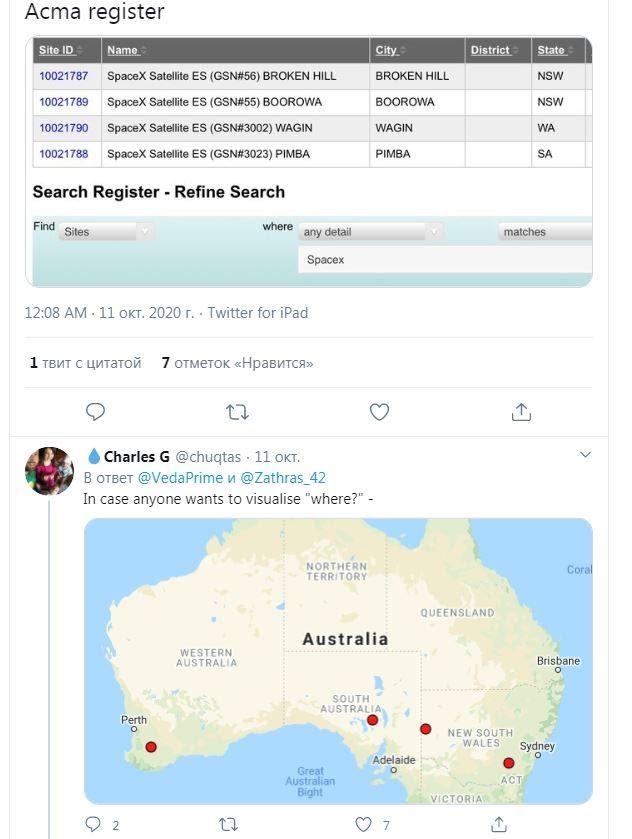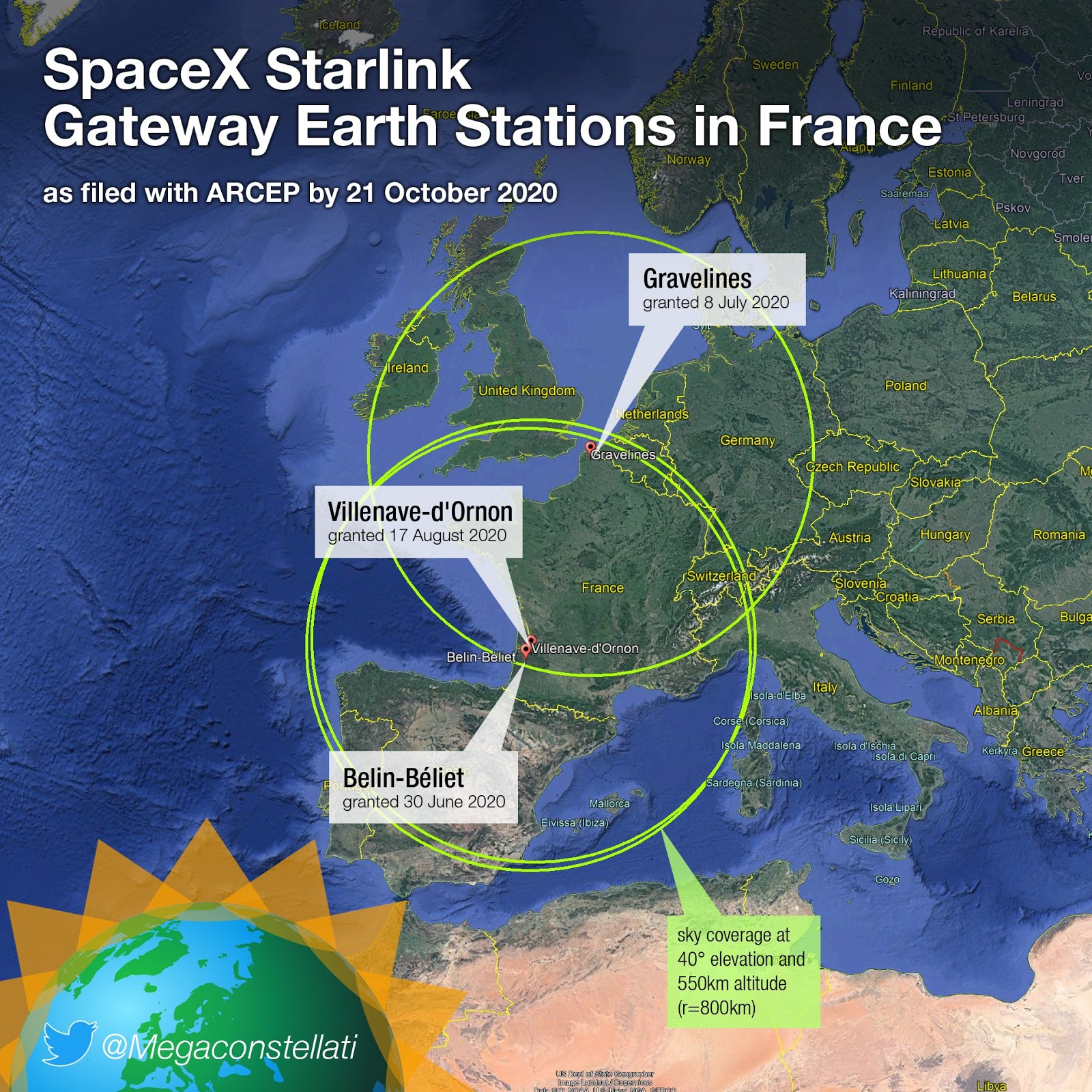Service in non-US markets
Canada is the second fastest-moving market for Starlink, and the coverage map suggests that the service will be provided via gateways in the US if SpaceX can prove to the Canadian Telecom Regulator (CRTC) that it meets its requirements. for the issuance of licenses. SpaceX already applied to CRTC in May 2020 for a license from the international Internet provider Basic International Telecommunications Services (BITS). At the same time, without waiting for the decision of the Canadian regulator on this application, SpaceX unexpectedly turned out to be the owner of SpaceX Canada Corp. (until recently it was called TIBRO Canada Corp .; the word ORBIT, written in reverse). Although this company had already received a BITS license in April 2019, that is, during the period when it was modestly called TIBRO Canada Corp.,and seemed to have nothing to do with SpaceX.

Recall that Canada has its own project of a low-orbit satellite constellation for Internet access, Telesat LEO, owned by Telesat Canada, the Canadian owner of the satellite constellation in geostationary orbit, and supported by the Government of Canada. SpaceX had yet to obtain a license (permit) from ISED (former Industry Canada) to use the radio frequency spectrum, which is a more difficult task. So far, nothing is known about the state of this process.
On October 18, 2020 Canadian regulator CRTC approved the license application for Basic International Telecommunications Services (BITS), an international Internet provider, filed by Space X on May 15, 2020.
And on November 7, 2020, ISED authorized SpaceX to use frequencies in Canada for the Starlink project.

Also in September 2020, two more foreign companies affiliated with Starlink became known. The first is Starlink Internet Services UK Limited, registered on 5 August 2020 in the UK at 2 Blagrave Street, Reading, Berkshire, RG1 1AZC with the right to the following activities:
- 61200 - Wireless telecommunications activities
- 61300 - Satellite telecommunications activities
- 61900 - Other telecommunications activities
Although the company is a public company, it has only issued one share and that has a declared value of £ 1. What is especially interesting is that the original owner of this legal entity was TIBRO Netherlands BV, which created it on August 5, 2020 in London, after which the company changed the owner and legal address in September 2020.
The second affiliate is SpaceX Netherlands BV Company Registration Number (KVK): 77925769. Location: Burgermeester Stramanweg 122 (this is where Tesla's European headquarters and (what a surprise!) TIBRO Netherlands BV) are located. On October 6, TIBRO Netherlands BV is listed as a German telecom provider (Gewerbliche Betreiber öffentlicher Telekommunikationsnetze und gewerbliche Erbringer öffentlich zugänglicher Telekommunikationsdienste nach § 6 TKG)
TIBRO AUSTRALIA PTY LTD, established in November 2019, Mr Michael Sylvester applied to ACMA (Australian Communications Authority) for an “ operator license ”. The license was issued on August 7, 2020. On October 3, TIBRO changed its name. Starlink Australia has 3 directors Lauren Dreyer, David Aderman, and Andrew Matlock, all of them SpaceX managers. The company is now called Starlink Australia PTY LTD. SpaceX has now agreed to place 4 gateways in Australia:

October 21 French telecom regulator ARCEP has approved TIBRO France SARL to deploy three gateways in France

An interesting story is developing in New Zealand.
The archives of the New Zealand Intellectual Property Office show that in January 2020, SpaceX applied for three trademarks to use the Starlink name in New Zealand. One application was for Class 9 goods related to commercial satellites, and the other two were for Class 38 and 42 services related to satellite communications. However, according to BusinessDesk, all three were rejected in one month due to similarities with trademarks owned by Subaru since 2012 for its Subaru Starlink automotive system.... SpaceX may object or amend applications by January 3, 2021, otherwise applications will be rejected. SpaceX hasn't taken any action yet, but it still has over two months to do it. SpaceX did not respond when asked to comment on its Starlink activities in New Zealand.
On September 10, 2020, in Mexico City, a meeting was held between Patricia Cooper (Vice President of Government Relations at SpaceX) and Adolfo Cuevas Teja (acting President of the Federal Institute of Telecommunications (IFT) of Mexico). The meeting discussed the issue of satellite communications regulations required for the operation of the SpaceX satellite constellation in Mexico.
The complete list of TIBRO companies registered in various countries of the world now looks like this:

It follows from the above that at least in the markets of Canada, the UK, Australia, the EU and other countries where TIBRO was established, SpaceX plans to work directly, creating 100% subsidiaries there.
It is highly likely that in other countries, with more confusing and / or US-unfriendly legislation, SpaceX will operate in a partnership model, selling subscriber terminals, gateway equipment and traffic to partners, possibly using a revenue sharing model. At the same time, the local partner will have to deal with pricing and solving problems with the local regulator.
In general, when discussing the operation of the Starlink service outside the United States, three aspects should be kept in mind:
- — Starlink , -.
- – SpaceX () — , — . — , , , , .
- — , , , -.
For Russia, all three aspects are quite problematic, because the greatest need for satellite Internet in Russia is observed in the North, which does not fall into the Starlink service area. As for the legalization of the service itself in the Russian Federation, the situation with respect to SpaceX is regulated by the decree of the government of the Russian Federation N1194 of November 14, 2014. It contains the rules written initially for OneWeb, and now inherited by Space X and its Starlink project: the territory of Russia of satellite communication networks under the jurisdiction of foreign states. "
This document reads in particular:
- «. 7. , , , , , , , ».
- «. 9. , , . , () … , ».
Thus, theoretically, this decree allows SpaceX to find a partner in Russia or, by founding its own subsidiary, to obtain the rights to use the frequency and orbital resource in the Russian Federation and then build interface stations (in fact, gateways) and equip them with SORM-3 equipment in accordance with with the requirements of the FSB to start providing services. At the same time, the question of the cost of the subscriber terminal, which in the Russian Federation, due to a number of peculiarities of our legislation, is usually sold to subscribers, and not leased, as well as the question of the availability of inter-satellite optical channels on satellites in the future, which theoretically allow traffic past the gateways. Based on the above, it is hardly worth expecting the appearance of the Starlink service in Russia in the next 3-5 years.
- « Starlink». 1.
- « Starlink». 2. Starlink
- « Starlink». 3.
- « Starlink». 4.
- « Starlink». 5. Starlink -
- « Starlink». 6. -
- « Starlink». 7. Starlink RDOF
- « Starlink». 8.